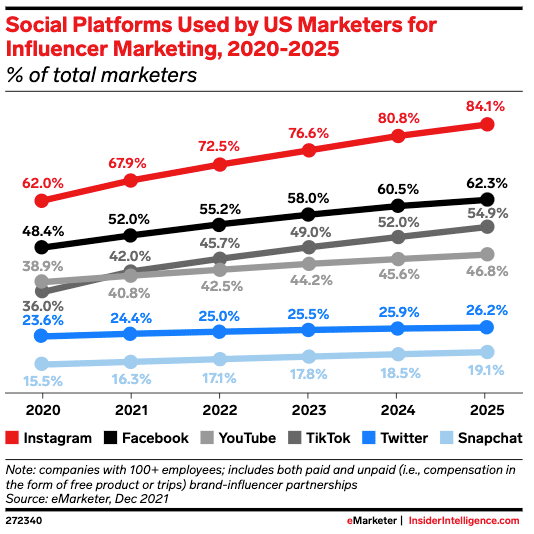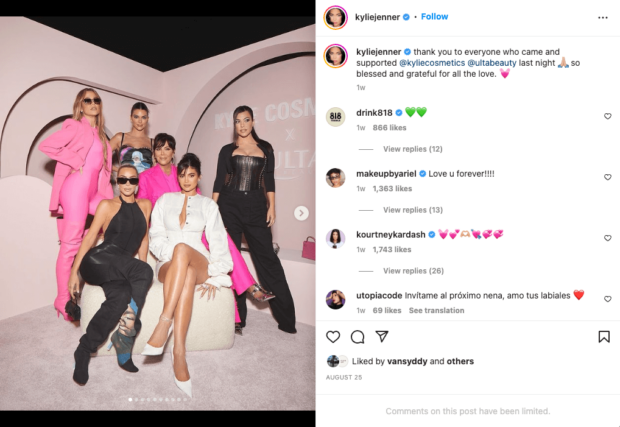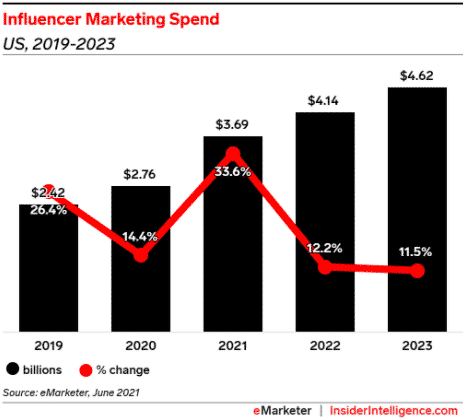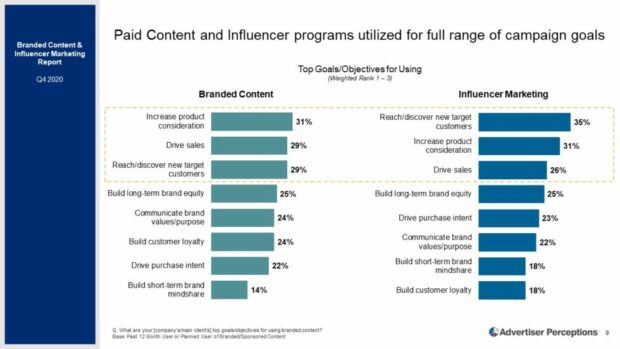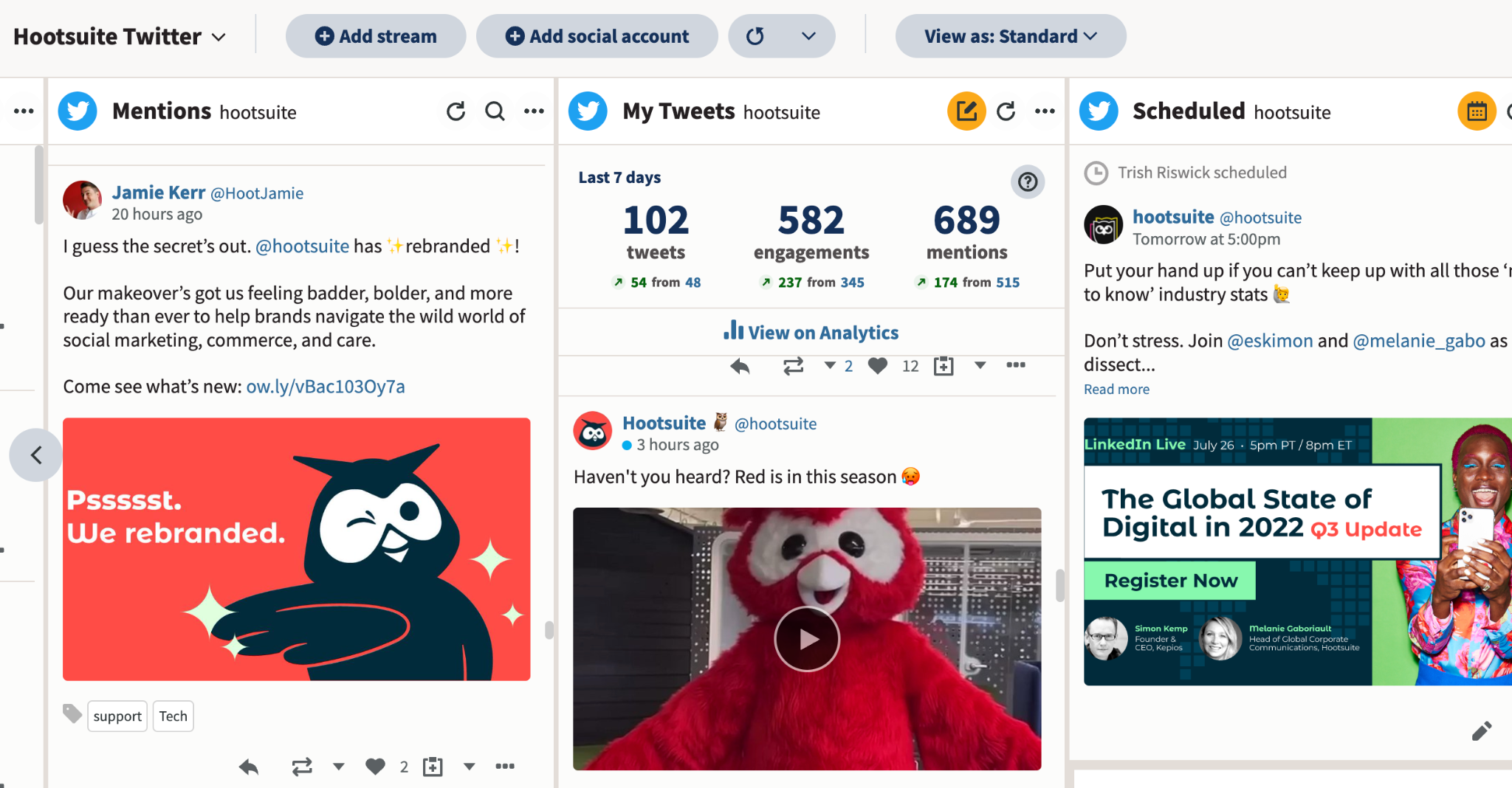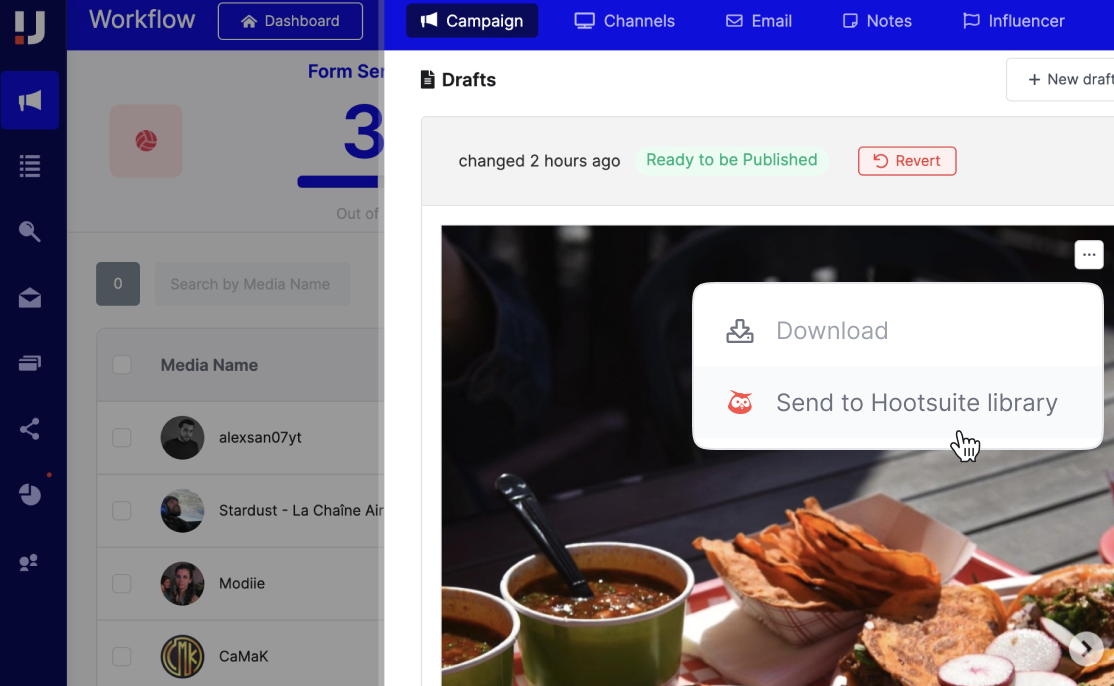Influencer marketing, also known as branded content or working with creators, is a surefire way to expand the reach of your brand on social media.
There’s no one-size-fits-all approach to making this strategy work, but with the right planning and research, just about every business can benefit. We’ll walk you through how to make a social media influencer program work for you, using examples from one of Hootsuite’s own successful influencer marketing campaigns.
Bonus: Get the influencer campaign template for brands to easily plan your next campaign and choose the best social media influencer to work with.
What is influencer marketing?
At its simplest, an influencer is someone who can influence others. In influencer marketing, a form of social media marketing, brands pay that person to promote their product or service to their followers.
Celebrity endorsements were the original form of influencer marketing. But in today’s digital world, social content creators with niche audiences can often offer more value to brands. These smaller accounts often have very engaged followers on social media.
So, a social media influencer is someone who wields their influence through social media. When you hire an influencer to promote your products or services, that’s influencer marketing.
Almost three-quarters (72.5%) of U.S marketers will use some form of influencer marketing this year — and that number is only going up over time.
Not convinced that advertising with influencers can lead to real business results? Civic Science found that 14% of 18-to-24-year-olds and 11% of millennials had bought something within the last six months because a blogger or influencer recommended it.
For now, Instagram remains the platform of choice for social influencers. According to eMarketer’s estimates, 76.6% of U.S. marketers will use Instagram for their influencer campaigns in 2023. But keep an eye on TikTok.
Source: eMarketer
While only 36% of U.S. marketers used TikTok for influencer campaigns in 2020, almost 50% will do so in 2023. That would make TikTok the third-most popular influencer marketing platform in 2023.
For example, with over 192,000 followers, creator Viviane Audi works with brands like Walmart and DSW on TikTok:
When you think “influencer,” does the Kardashian-Jenner family pop immediately to mind?
Source: @kyliejenner on Instagram
While these famous sisters are certainly some of the top social media marketing influencers, not all influencers are celebrities.
In fact, for many brands, influencers with a smaller but dedicated or niche follower base might be more effective. Influencers with 15,000 followers have some of the highest engagement rates on all platforms*. The cost, of course, can also be much lower.
Let’s look at the different types of Instagram influencers based on audience size. There’s no strict cut-off for audience size, but generally the types of influencers are broken down as:
Nano-influencers
Nano-influencers have 10,000 followers or fewer, like mommy blogger Lindsay Gallimore (7.8K followers)
Micro-influencers
Micro-influencers have 10,000 to 100,000 followers, like lifestyle blogger Sharon Mendelaoui (12.3K followers)
Macro-influencers
Macro-influencers have 100,000 to 1 million followers, like food and travel creator Jean Lee (109K followers)
Mega-influencers
Mega-influencers have 1 million+ followers, like TikTok star Savannah LaBrant (30.3M followers)
Influencers with extensive reach rightly expect to be paid for their work. Free product might work with nano-influencers, but a larger influencer campaign requires a budget.
For large brands working with celebrity influencers, that budget may be quite large. U.S. spending on influencer marketing, for example, is set to top $4 billion in 2022.
Source: eMarketer
Think about what kind of payment structure makes the most sense for your goals. But be willing to consider the influencer’s needs, too. For example, an affiliate or commission structure might be an option instead of a flat fee, or to reduce the flat fee.
In fact, 9.3% of U.S. influencers said affiliate marketing (through affiliate links and promo codes) was their top source of income.
That said, the most common baseline pricing formula for influencers’ Instagram posts is:
$100 x 10,000 followers + extras = total rate
What are the extras? Check out our post on influencer pricing for all the details.
Remember that micro-influencers and nano-influencers will have more flexible payment terms.
How to create an influencer marketing strategy
1. Determine your goals
The number-one goal for brands using influencer marketing is to reach new target customers. This makes sense, since an influencer campaign extends your reach to that person’s followers.
Notice that the goal is simply to reach new customers, not necessarily to make a sale right off the top. Driving sales is actually the third most common goal of influencer marketing campaigns, after increasing brand awareness and product consideration.
Source: Advertiser Perceptions
Think about how your influencer marketing plan will fit into your broader social media marketing strategy and create measurable goals you can report on and track.
We’ve got a whole blog post on goal-setting strategies to get you started.
To promote the launch of Hootsuite’s Social Media Career Report, our social team chose to partner with prominent social media experts for a LinkedIn influencer campaign.
“LinkedIn has such an amazing community of creators, from e-mail marketing enthusiasts to HR professionals, and you can really find your crowd there,” said Eileen Kwok, Hootsuite’s Social Marketing Specialist. “I knew there was a huge and active community of social media managers on LinkedIn, but it’s also the best social media platform to reach executives, so I wanted to test the waters of working with LinkedIn creators.”
2. Know who you’re trying to influence
An effective influencer marketing strategy requires you to speak to the right people using the right tools—and the right influencers.
The first step is to define who your audience will be for this specific campaign.
Developing audience personas is a great way to make sure you understand who you’re trying to reach. Maybe you’re trying to reach more of your current audience—or an entirely new audience.
Once you’ve decided, create a matching set of influencer personas. This will help you understand the qualities you’re looking for in your influencers.
For our Career Report, Kwok identified two target audiences on LinkedIn: marketing decision-makers and social media marketing professionals.
“We wanted to help executives better understand the role of a social media manager and how to support their growth,” said Kwok.
“We also wanted to encourage the community of social marketing professionals on LinkedIn to feel inspired by our influencers to share their stories.”
3. Understand the rules
Before you dive into influencer marketing, it’s important to understand the rules. In the United States, those rules come from the Federal Trade Commission.
The FTC takes disclosure very seriously. Make sure you build disclosure guidelines into your agreements with influencers.
Influencers must identify sponsored posts. However, they do not always do so. Or they might do so in such a subtle way that the disclosure is effectively hidden or incomprehensible.
In the UK, for example, the Competition and Markets Authority (CMA) investigated “hidden advertising” on Instagram and pressed parent company Facebook to commit to changes that make disclosure easier and more clear.
The specific rules vary slightly by country, so be sure to check the most current requirements in your jurisdiction. For the most part, you just need to be clear and upfront so viewers understand when a post is sponsored in any way.
Here are some key points from the FTC:
- Video reviews must include both written and verbal disclosure of the partnership. It must be within the video itself (not just the description).
- The built-in tools on social media platforms alone are not enough. However, you should still use them. Instagram itself now specifies that any branded content (aka influencer marketing) on the platform must use the Branded Content tag to identify the relationship. This adds the text “Paid partnership with [your brand name]” in the post header.
- #ad and #sponsored are great hashtags to use for disclosure. But make sure they’re highly visible and not just tacked on to the need of a long string of tags.
That last point is an important one. Some influencers may be wary about putting the #ad or #sponsored hashtag right up front. But that’s where it needs to be.
Influencers: If “#ad” is mixed in with links or other hashtags at the end of a post, some readers may just skip over it. Be sure to place “#ad,” or “#Sponsored,” or another easily understood disclosure where it easily noticed and understood. Learn more: https://t.co/oDk34TTSxb pic.twitter.com/dB9kj5qlzO
— FTC (@FTC) November 23, 2020
4. Consider the three Rs of influence
Influence is made up of three components:
- Relevance
- Reach
- Resonance
Relevance
A relevant influencer shares content relevant to your business and industry. They need to have an audience that aligns with your target audience.
For example, to showcase their inclusive swimsuit sizing, Adore Me partnered with body positive creator Remi Bader.
With 3.2 million views on Bader’s TikTok and more than 8,800 likes on her Instagram Reels, the video exposed the line to an impressive organic audience of dedicated followers.
Adore Me also used Bader’s content to create an Instagram ad combined with an Instant Experience. That influencer ad campaign drove a 25% increase in subscription opt-in with a 16% lower cost per customer than their usual Instagram ad campaigns.
Reach
Reach is the number of people you could potentially reach through the influencer’s follower base. Remember: a small audience can be effective, but you need to make sure there’s enough of a following to align with your goals.
Resonance
This is the potential level of engagement the influencer can create with an audience relevant to your brand.
Not to belabour the point, but bigger isn’t always better. As we said above, a huge follower count is meaningless if those followers aren’t interested in your offer. Niche influencers, on the other hand, can have very dedicated and engaged followers.
In order for Hootsuite’s campaign to be successful, Kwok knew that the partnerships would have to be authentic. “It was important that our campaign spoke to each influencer’s community of followers and aligned with their regular content,” she shared.
“Before the campaign even started, I already had a couple of creators in mind — I’ve been following them for a while, and they made me hopeful about my own career prospects as a social media manager,” said Kwok. “They showed me it was possible to move up to an executive position or create your own agency.”
5. Compile a short list of influencers
When thinking about who you want to work with, the key is trust. Your audience must trust and respect the opinions of the influencers you partner with. Without the trust component, any results will be superficial. You’ll struggle to see a tangible business impact from your efforts.
How do you tell if your potential influencer is trusted? Engagement. You want to see plenty of views, likes, comments, and shares. Specifically, you want to see these from the precise follower segments you’re trying to reach.
A good engagement rate also means a loyal following, rather than an inflated follower count bolstered by bots and fraud accounts. You need to find someone who’s producing content with a look and feel that complements your own.
The tone must also be appropriate for the way you want to present your brand to potential customers. This will ensure things don’t feel disjointed in either party’s social media posts.
When narrowing down the list of potential partners for Hootsuite’s campaign, Kwok looked for influencers with an engaged audience (at least 300 engagements per post). “When I’m evaluating potential partners, I always look at their comment sections, too,” Kwok said. “Comments are good way to gauge if their audience is echoing the sentiment of their posts and if they have a loyal fan base.”
6. Do your research
Take a look at what your potential influencers are posting. How often are they sharing sponsored content?
If they’re already hitting followers with tons of paid posts, their engagement rate may not last. Look for plenty of organic, non-paid content to keep followers interested, enthusiastic, and engaged.
Keep this in mind when thinking about what you’ll ask the influencer to post, as well. Asking for too many posts in a short timeframe will make your offer hard for the influencer to accept, even if it comes with a large paycheck.
In-demand influencers get lots of offers. When you first approach an influencer, you’ll need to show that you’ve put in the time to learn what they do.
Make sure you know exactly what their channels are about and who their audience is.
7. Reach out privately, and personally
Start your communication with a new potential partner slowly by interacting organically with their posts. Like their content. Comment when appropriate. Be appreciative, not salesly.
When you’re ready to suggest a partnership, a direct message is a great place to start. If you can find an email address, try that too. But don’t send a mass email or generic DM.
It may take a little longer to write a personal message to each influencer. But, it will show you’re serious about the potential partnership. This will in turn increase your chances of striking a deal.
Provide as much information as you can about your brand. Tell them what you hope to accomplish with your Instagram campaign. Make it clear how the influencer will benefit, beyond the paycheck.
One key thing to keep in mind during this process: You may not actually want to use the word “influencer” when reaching out to potential partners. Content creators prefer to be called just that—creators—and may view “influencer” as a bit of an insult that belittles their work.
8. Collaborate with your influencer to develop effective content
A social media influencer who has worked hard to build a following will not accept a deal that makes their own personal brand seem inconsistent.
After all, influencers are content creation experts. This is why they prefer to be called creators. You’ll get the best value from their work by allowing them to showcase those skills.
It’s a good idea to provide some guidelines about what you’re looking for, of course. But don’t expect to stage-manage the entire campaign.
For Hootsuite’s campaign, Kwok asked partners to share personal stories from their own social media careers.
“I wanted them to craft a post that spoke to their experience and mentioned our report,” she said. “I really didn’t want to micromanage—after all, people know what performs best on their platforms—so I gave them the creativity to write about what they wanted.”
But the story wasn’t everything. “I also knew the post would need a strong visual to really stand out. It needed to really say ‘social’ and make people stop scrolling,” she said.
“That’s when I had the idea to play into the @dudewithsign format, a reference that so many social media managers know and love. I asked one of our designers to create a custom Hootsuite branded whiteboard for us, sent it to our creators, and asked them to write their own ‘hot take’ that fit well with the post.”
Here’s one of those posts, created by social media strategist Jon-Stephen Stansel.
9. Measure your results
When you launch your influencer campaign, it can be tempting to focus on vanity metrics like likes and comments. If your influencer has a much larger following than you do, you might feel a little dazzled by the sheer number of likes that can rack up.
But to measure the effectiveness of a campaign, you have to understand its value in terms of return on investment. Luckily, there are plenty of ways to measure your campaign’s success.
UTM parameters are one way to track the visitors an influencer sends to your website. They can also help measure how much engagement the campaign receives.
When you assign each influencer their own unique links with UTM codes, you’ll get a clear picture of the results. That allows you to calculate the impact on your bottom line.
The “coupon” link referred to in the above influencer’s post likely had a UTM attached to it so that Royale could track how many sales came from it.
Giving influencers their own discount code is another easy way to track the sales they send your way.
If you use the branded content tools on Facebook and Instagram for your influencer campaigns, you’ll get access to insights for both feed and Stories posts. You can access these through Facebook Business Manager.
You could also request that the influencer send you detailed reports on the reach and engagement levels of their posts.
And as for Hootsuite’s influencer campaign? “It was a great success!” said Kwok. “Posts quickly blew up on social, with thousands of social media managers commenting that they felt seen, understood, and heard, which was really the point of this report from the start.”
“In the end,” Kwok said, “We worked with eight influencers and had 12 sponsored posts across LinkedIn and Twitter. We received 1.2 million impressions from just the influencers’ posts and earned an additional 20,000 engagements, 8,000 link clicks, and 1,200 leads.”
(Oh, and if you want to hear more about Hootsuite’s campaign, check out coverage in Fast Company and The CMO!)
Influencer marketing tools
Now that you’re ready to get started with influencer marketing, here are some tools to make it easier.
Hootsuite
Hootsuite search streams can help you discover influencers by monitoring conversations relevant to your industry across multiple channels.
Once you have an initial set of influencers in mind, add them to a stream to track what they share and who they engage with. This will help you understand their relevance to your audience while highlighting other potential influencers to work with.
Hootsuite also integrates with the renowned influencer platform Upfluence — more on that below!
Collabstr is a free marketplace where brands can search for influencers based on platform, niche, location, and more. From there, you can place orders with influencers and communicate with them directly through the platform until the deliverables have been submitted.
Right Relevance Pro
This app can search out top content shared by influencers based on topic and location. Use it to identify thought leaders and discover potential influencer partnerships based on the quality of the content they share.
Fourstarzz Influencer Recommendation Engine
This app provides custom influencer recommendations. It helps predict estimated reach, engagements, and other campaign results and guides you in creating influencer campaign proposals.
Insense
Insense connects brands with a network of 35,000 content creators to produce custom branded content. You can then promote the content through ads on Facebook and Instagram, optimize content for Instagram Stories, and use the AI video editor to break up content into multiple videos.
Facebook Brand Collabs Manager
This free tool from Facebook allows brands to connect with pre-screened content creators on Facebook and Instagram.
Influencer marketing platforms
Want to use an influencer marketing platform to connect directly with influencers? Some of the best include:
Personally, I recommend Upfluence. It seamlessly integrates with Hootsuite (for free!), and the two tools work together to help you:
- Send influencer-generated content from Upfluence to Hootsuite, in just one click
- Effortlessly schedule and publish your brand’s influencer content across your social media
- Amplify the reach and the impact of your Influencer Marketing campaigns with influencer content shares
Make influencer marketing easier with Hootsuite. Schedule posts, research and engage with influencers in your industry, and measure the success of your campaigns. Try it free today.
*Source: Influencer Marketing Hub


